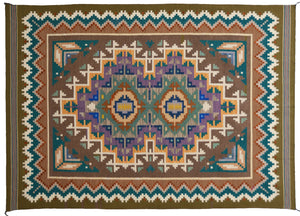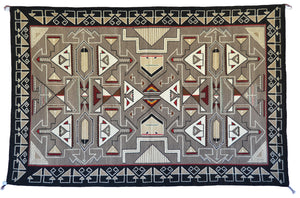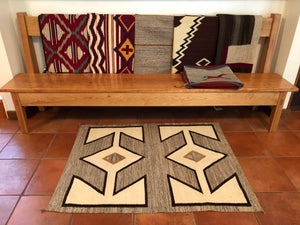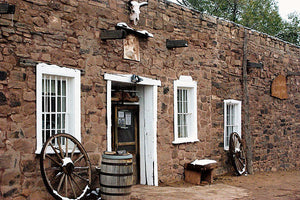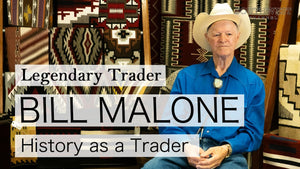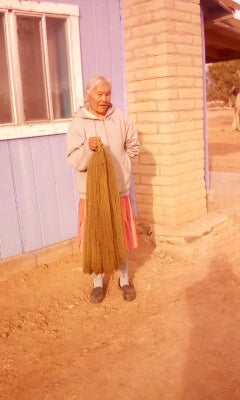In the last part of the 19th century as trading posts began to open and lure consumers who were visiting the Western United States, there was a shift in the Native American art market from creating wearing blankets to weaving floor rugs. This period, which spanned approximately 40 years, from the 1880s to the 1910s, has become known as the transitional period with the textiles made by Navajo weavers reflecting the same name. Jellybean transitional blanket, ca. 1880s, handcrafted, hand-spun, Native wool, aniline dyes.
Jellybean transitional blanket, ca. 1880s, handcrafted, hand-spun, Native wool, aniline dyes.
On view now at Nizhoni Ranch Gallery in Sonoita, Arizona, are approximately 50 transitional weavings that are available for purchase. The appointment-only gallery will highlight the work that has become recognized for its beautiful wool, out of the box designs and having an ideal price point for collectors. Transitional pictorial of medicine bags, ca. 1900, positive/negative design, hand-carded, hand-spun, hand-dyed Merino wool, aniline dyes.
Transitional pictorial of medicine bags, ca. 1900, positive/negative design, hand-carded, hand-spun, hand-dyed Merino wool, aniline dyes.
 Optical art Crystal transitional blanket, ca. 1900, hand-carded, hand-spun, Merino wool with aniline red dye.
Optical art Crystal transitional blanket, ca. 1900, hand-carded, hand-spun, Merino wool with aniline red dye.
“In the late 1880s, a trader by the name of J.B. Moore arrived on the reservation. He recognized there was a demand for floor rugs. Moore began working closely with weavers, influencing them to ‘transition’ from weaving blankets to weaving rugs,” says the gallery’s owner Steve Getzwiller. Moore created a catalog that included a number of designs, known as plates, that the artists would replicate or create their own variations. A circa 1900 transitional J.B. Moore Navajo rug, plate #XII with native wool on view at Nizhoni Ranch Gallery.
A circa 1900 transitional J.B. Moore Navajo rug, plate #XII with native wool on view at Nizhoni Ranch Gallery.
Included in the exhibition are several of these examples, such as a circa 1900 textile featuring plate #XII and a transitional weaving from the Crystal area that is a variant of plate #V, also from around 1900.
“Transitional rugs do have specific attributes. The wool was made from Merino and Churro sheep and other native wool,” Getzwiller explains. “The wool was hand-carded, hand-dyed with a thick/heavy spin appropriate for use on the floor. In the transitional period Navajo had access to man-made dyes in bright colors. Weavers loved the new bright colors.” Transitional Navajo textile, ca. 1900, hand-carded, hand-spun Merino wool, aniline red dye with indigo blue.
Transitional Navajo textile, ca. 1900, hand-carded, hand-spun Merino wool, aniline red dye with indigo blue.
One of the major highlights of the exhibition is a jellybean transitional blanket, circa 1880s. The piece, which Getzwiller says has “outrageous color and design,” features a zigzag style pattern in oranges, reds and greens. Also in the show is an optical art Crystal transitional blanket from circa 1900 and a transitional pictorial of medicine bags from around 1900.  Churro sheep pictorial, ca. 1910, hand-carded, hand-spun all-natural Churro wool.
Churro sheep pictorial, ca. 1910, hand-carded, hand-spun all-natural Churro wool.
A circa 1910 Churro sheep pictorial is another textile of note in the show. According to Getzwiller, as the pictorial is of a two-toned sheep in natural wool, “This transitional was probably a memorial weaving to the ‘old sheep’ used for weaving classical blankets.”
The exhibition will remain on view in the gallery through February 2020. —
Nizhoni Ranch Gallery
Through February 2020
Sonoita, AZ 85637
(520) 455-5020 • www.navajorug.com


